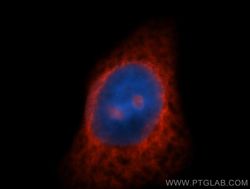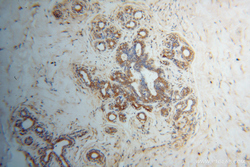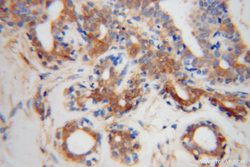Antibody data
- Antibody Data
- Antigen structure
- References [7]
- Comments [0]
- Validations
- Western blot [1]
- Immunocytochemistry [1]
- Immunohistochemistry [2]
Submit
Validation data
Reference
Comment
Report error
- Product number
- 15340-1-AP - Provider product page

- Provider
- Proteintech Group
- Proper citation
- Proteintech Cat#15340-1-AP, RRID:AB_2254051
- Product name
- RPL7A antibody
- Antibody type
- Polyclonal
- Description
- RPL7A antibody (Cat. #15340-1-AP) is a rabbit polyclonal antibody that shows reactivity with human, mouse, rat and has been validated for the following applications: IF, IHC, IP, WB,ELISA.
- Reactivity
- Human, Mouse, Rat
- Host
- Rabbit
- Conjugate
- Unconjugated
- Isotype
- IgG
- Vial size
- 20ul, 150ul
Submitted references Nuclear and cytoplasmic specific RNA binding proteome enrichment and its changes upon ferroptosis induction.
UBE2S targets RPL26 for ubiquitination and degradation to promote non-small cell lung cancer progression via regulating c-Myc.
The induction of p53 correlates with defects in the production, but not the levels, of the small ribosomal subunit and stalled large ribosomal subunit biogenesis.
Inefficient quality control of ribosome stalling during APP synthesis generates CAT-tailed species that precipitate hallmarks of Alzheimer's disease.
Estrogen-Related Hormones Induce Apoptosis by Stabilizing Schlafen-12 Protein Turnover.
Phosphorylation-dependent Regnase-1 release from endoplasmic reticulum is critical in IL-17 response.
Regnase-1 and Roquin Regulate a Common Element in Inflammatory mRNAs by Spatiotemporally Distinct Mechanisms.
Sun H, Fu B, Qian X, Xu P, Qin W
Nature communications 2024 Jan 29;15(1):852
Nature communications 2024 Jan 29;15(1):852
UBE2S targets RPL26 for ubiquitination and degradation to promote non-small cell lung cancer progression via regulating c-Myc.
Gong D, Rao X, Min Z, Liu X, Xin H, Zhou P, Yang L, Li D
American journal of cancer research 2023;13(8):3705-3720
American journal of cancer research 2023;13(8):3705-3720
The induction of p53 correlates with defects in the production, but not the levels, of the small ribosomal subunit and stalled large ribosomal subunit biogenesis.
Eastham MJ, Pelava A, Wells GR, Lee JK, Lawrence IR, Stewart J, Deichner M, Hertle R, Watkins NJ, Schneider C
Nucleic acids research 2023 Sep 22;51(17):9397-9414
Nucleic acids research 2023 Sep 22;51(17):9397-9414
Inefficient quality control of ribosome stalling during APP synthesis generates CAT-tailed species that precipitate hallmarks of Alzheimer's disease.
Rimal S, Li Y, Vartak R, Geng J, Tantray I, Li S, Huh S, Vogel H, Glabe C, Grinberg LT, Spina S, Seeley WW, Guo S, Lu B
Acta neuropathologica communications 2021 Oct 18;9(1):169
Acta neuropathologica communications 2021 Oct 18;9(1):169
Estrogen-Related Hormones Induce Apoptosis by Stabilizing Schlafen-12 Protein Turnover.
Li D, Chen J, Ai Y, Gu X, Li L, Che D, Jiang Z, Li L, Chen S, Huang H, Wang J, Cai T, Cao Y, Qi X, Wang X
Molecular cell 2019 Sep 19;75(6):1103-1116.e9
Molecular cell 2019 Sep 19;75(6):1103-1116.e9
Phosphorylation-dependent Regnase-1 release from endoplasmic reticulum is critical in IL-17 response.
Tanaka H, Arima Y, Kamimura D, Tanaka Y, Takahashi N, Uehata T, Maeda K, Satoh T, Murakami M, Akira S
The Journal of experimental medicine 2019 Jun 3;216(6):1431-1449
The Journal of experimental medicine 2019 Jun 3;216(6):1431-1449
Regnase-1 and Roquin Regulate a Common Element in Inflammatory mRNAs by Spatiotemporally Distinct Mechanisms.
Mino T, Murakawa Y, Fukao A, Vandenbon A, Wessels HH, Ori D, Uehata T, Tartey S, Akira S, Suzuki Y, Vinuesa CG, Ohler U, Standley DM, Landthaler M, Fujiwara T, Takeuchi O
Cell 2015 May 21;161(5):1058-1073
Cell 2015 May 21;161(5):1058-1073
No comments: Submit comment
Supportive validation
- Submitted by
- Proteintech Group (provider)
- Main image

- Experimental details
- MCF7 cells were subjected to SDS PAGE followed by western blot with 15340-1-AP(RPL7A antibody) at dilution of 1:500
- Sample type
- cell line
Supportive validation
- Submitted by
- Proteintech Group (provider)
- Main image

- Experimental details
- Immunofluorescent analysis of HepG2 cells, using RPL7A antibody 15340-1-AP at 1:50 dilution and Rhodamine-labeled goat anti-rabbit IgG (red). Blue pseudocolor = DAPI (fluorescent DNA dye).
- Sample type
- cell line
Supportive validation
- Submitted by
- Proteintech Group (provider)
- Main image

- Experimental details
- Immunohistochemical of paraffin-embedded human breast cancer using 15340-1-AP(RPL7A antibody) at dilution of 1:100 (under 10x lens)
- Sample type
- tissue
- Submitted by
- Proteintech Group (provider)
- Main image

- Experimental details
- Immunohistochemical of paraffin-embedded human breast cancer using 15340-1-AP(RPL7A antibody) at dilution of 1:100 (under 40x lens)
- Sample type
- tissue
 Explore
Explore Validate
Validate Learn
Learn Western blot
Western blot ELISA
ELISA